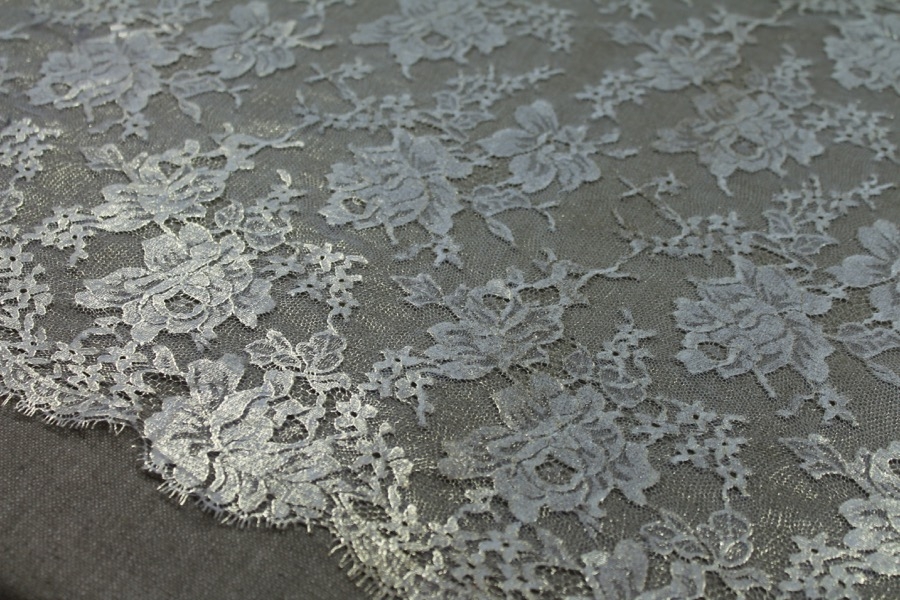We use cookies to make your experience better. To comply with the new e-Privacy directive, we need to ask for your consent to set the cookies. Learn more.
Chantilly Lace
Chantilly lace is a delicate and intricate lace known for its fine details and exquisite patterns. It is named after Chantilly, a town 50km north of Paris. The town boasts a fine lace-making tradition, dating back to the 17th century.
-
 LAST PIECE - White Chantilly lace, gold foiled, rose design. Double scalloped.Special Price £159.00 Regular Price £190.00
LAST PIECE - White Chantilly lace, gold foiled, rose design. Double scalloped.Special Price £159.00 Regular Price £190.00
Chantilly Lace - what you need to know
Chantilly lace is a delicate and intricate lace known for its fine details and exquisite patterns. Here's what you need to know about Chantilly lace before using it.
By understanding these characteristics and handling techniques, you can effectively use Chantilly lace in your sewing and design projects, ensuring beautiful and professional results.
Characteristics of Chantilly Lace:
-
Origin:
- Named after Chantilly, a town in France known for its lace-making tradition that dates back to the 17th century.
-
Appearance:
- Fine and Delicate: Features fine, detailed patterns often with floral motifs.
- Sheer Ground: Made on a net or tulle base, giving it a sheer appearance.
- Soft and Lightweight: Soft to the touch and lightweight, drapes beautifully.
-
Pattern:
- Floral and Scroll Motifs: Typically features intricate floral and scroll designs.
- Outline Threads: Often has a heavier thread outlining the pattern, adding definition.
-
Colour:
- Traditionally in black, but also available in white, ivory, and other colors.
Working with Chantilly Lace:
-
Handling:
- Delicate: Requires gentle handling to avoid tearing or damaging the intricate designs.
- Pins and Clips: Use fine pins or fabric clips sparingly to avoid leaving holes or marks.
-
Cutting:
- Sharp Tools: Use sharp scissors or a rotary cutter for clean edges.
- Stabilizing: Stabilize the lace with tissue paper or a lightweight stabilizer when cutting to prevent shifting.
-
Sewing:
- Needles: Use a fine needle (size 60/8 or 70/10) to prevent snags.
- Stitch Length: Opt for a shorter stitch length (1.5-2 mm) to avoid damaging the lace.
- Seams: French seams or zigzag stitches can be used to finish edges, maintaining the lace’s delicate appearance.
-
Pressing:
- Low Heat: Use a low heat setting and a pressing cloth to avoid direct contact with the lace.
- Steaming: Steaming is preferable to prevent flattening the lace’s texture.
Maintenance:
-
Cleaning:
- Dry Cleaning: Recommended to maintain the lace’s delicate structure and prevent damage.
- Hand Washing: If hand washing, use cold water and mild detergent, and handle gently.
-
Storing:
- Flat Storage: Store flat or rolled to avoid creases and stretching.
- Cool, Dry Place: Keep in a cool, dry place away from direct sunlight to prevent discoloration.
Usage:
-
Fashion:
- Bridal Wear: Popular for wedding dresses, veils, and accessories due to its romantic and elegant appearance.
- Evening Wear: Used in evening gowns, cocktail dresses, and lingerie.
- Accents and Trims: Often used as trim or overlay to add decorative elements to garments.
-
Accessories:
- Veils and Shawls: Chantilly lace is a favorite for making delicate veils and shawls.
- Lingerie: Adds a touch of luxury to lingerie and undergarments.
Challenges:
- Delicacy: The fine nature of Chantilly lace makes it susceptible to tearing and requires careful handling.
- Fraying: Edges can fray easily, so finishing seams properly is important.
- Cost: Authentic Chantilly lace can be expensive due to the intricate work involved in its creation.




















